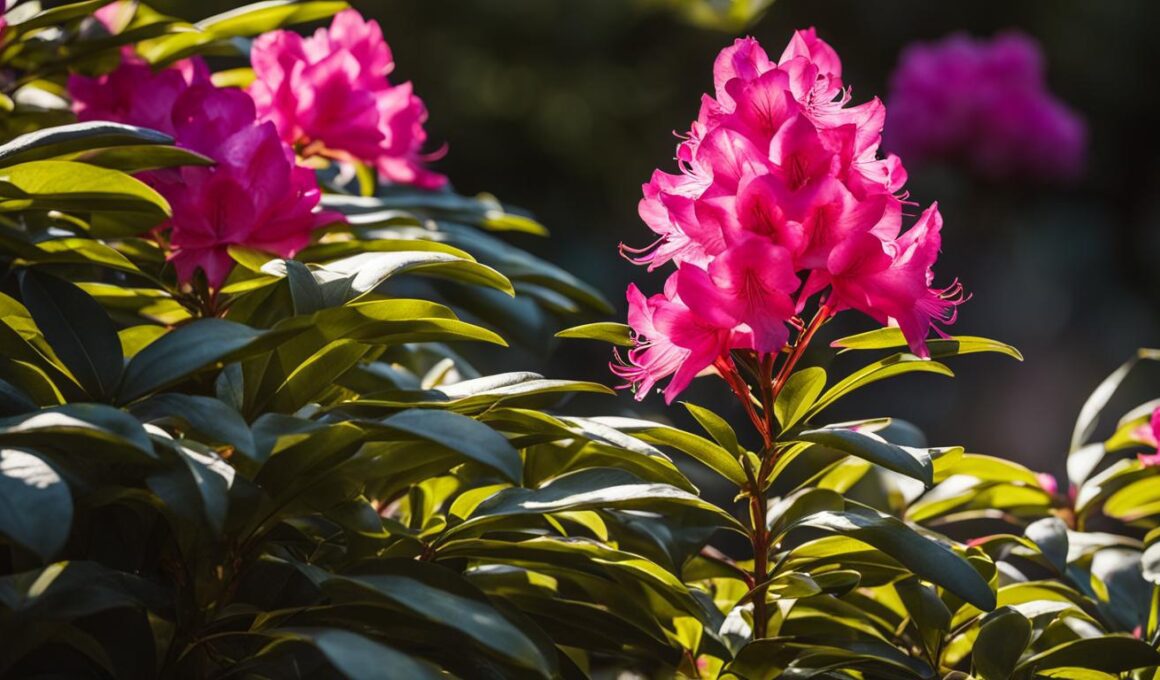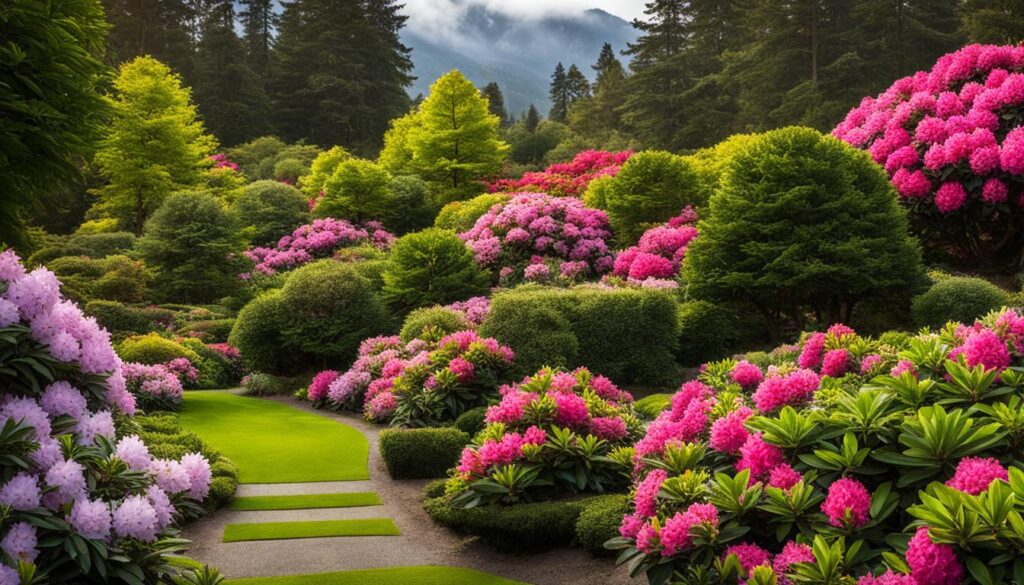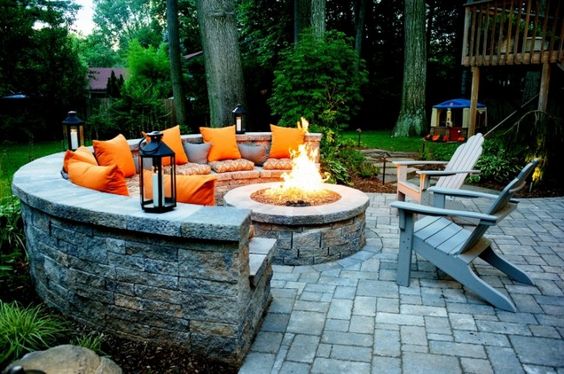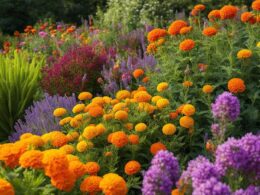Are you wondering whether rhododendrons prefer sun or shade in your American garden? We have the expert advice you need to create optimal conditions for these beautiful shrubs.
Rhododendrons are large, evergreen shrubs that bloom in a variety of colors, making them the perfect statement pieces in any garden. While they can tolerate full sun conditions, they thrive best in partial sun/shade. It’s important to provide them with the right balance of sunlight to ensure optimal growth and flower production.
Post Summary
- Rhododendrons prefer partial sun/shade for optimal growth
- They need at least 2-4 hours of direct sunlight every day
- Full sun can lead to drying and lace bug infestation
- Planting them in deep shade will result in flowerless shrubs with leggy growth
- Choosing the right varieties and providing proper care will help your rhododendrons thrive in your garden
Growing Rhododendrons in Sun or Shade
If you’re considering growing rhododendrons in your garden, it’s important to understand their sunlight requirements. Rhododendrons are adaptable plants that can tolerate a range of light conditions, but their growth and flower production are influenced by the amount of sun or shade they receive.
While rhododendrons are adapted to wooded areas and can tolerate full sun, prolonged exposure to intense sunlight can lead to issues such as drying and lace bug infestations. On the other hand, planting them in deep shade will result in flowerless shrubs and leggy growth.
The optimal light exposure for growing rhododendrons is partial shade. This provides a balance of direct sunlight and dimness throughout the day, helping to protect the shrubs from insect infestations. Aim for at least 2-4 hours of direct sun each day to ensure proper flower production. By choosing the right light conditions, you can create an ideal environment for your rhododendrons to thrive.
Growing Rhododendrons in Different Light Conditions
Depending on the variety, climate, and region, rhododendrons have varying sunlight needs. Some hybrids are more tolerant of both sun and shade, making them suitable for gardens where there are areas of both light exposures. These hardy hybrids, such as ‘PJM Elite’, ‘Olga Mezzitt’, and ‘Victor’, offer a range of flower colors and growth habits.
| Rhododendron Hybrid | Light Exposure | Special Features |
|---|---|---|
| ‘PJM Elite’ | Tolerates both sun and shade | Dense foliage, vibrant purple flowers |
| ‘Olga Mezzitt’ | Tolerates both sun and shade | Compact growth, clusters of pink flowers |
| ‘Victor’ | Tolerates both sun and shade | Large, showy trusses of lavender flowers |
It’s important to note that rhododendrons are shallow-rooted plants, and excessive sunlight can cause them to dry out quickly. To prevent this, partial shade is the most recommended light exposure. It helps to keep the soil moist and prevents the roots from drying out too rapidly. By providing the right light conditions for your rhododendrons, you can enjoy their beautiful blooms and lush foliage in your garden.
Rhododendrons and Full Shade
While rhododendrons can survive in fully shaded areas, they do not thrive well in these conditions. They may have leggy and weaker growth, and lack flower production. Rhododendrons need at least some dappled sunlight to produce flowers and develop strong growth. It is not recommended to plant rhododendrons in full shade. However, there are other flowering plant species, like camellias and hostas, that are suitable for fully shaded gardens.
When it comes to rhododendrons, finding the right balance of sunlight is crucial. While they require some direct sunlight, planting them in areas with full shade can result in disappointing growth and limited blooming. It is important to understand that even in fully shaded gardens, there are still opportunities to introduce vibrant and colorful flowering plants.
Rhododendrons versus other flowering plants in full shade:
“While rhododendrons may struggle to bloom in full shade, other flowering plant species like camellias and hostas are better suited to these light conditions. Camellias are known for their showy flowers, and with the right cultivar selection, they can thrive in fully shaded areas. Hostas, on the other hand, are valued for their attractive foliage and can add a lush green backdrop to shady corners of the garden.” – Expert Gardener
Therefore, if you have areas in your garden that receive full shade, consider exploring these alternative flowering plant species that are better adapted to flourish in such conditions. By diversifying your plant selection, you can create a beautiful and thriving garden even in areas with limited sunlight.
| Flowering Plant Species | Main Attraction | Recommended Light Conditions |
|---|---|---|
| Rhododendrons | Colorful blooms | Partial shade to full sun |
| Camellias | Showy flowers | Full shade to partial shade |
| Hostas | Attractive foliage | Full shade to partial shade |
Rhododendrons and Partial Shade
Growing rhododendrons in partial shade is highly recommended to provide them with a light exposure that closely resembles their native woodland habitat. In partial shade, rhododendrons receive both direct sunshine and dimness throughout the day, which offers several benefits. Firstly, partial shade protects the shrubs from insect infestations that may be more prevalent in full sun conditions. Additionally, partial shade helps prevent the rapid drying out of rhododendrons, as these shrubs have shallow root systems and can be sensitive to excessive sunlight.
When planting rhododendrons in partial shade, it’s important to find the right balance of light exposure. Avoid planting them in areas with too much heavy shade, as this can limit their growth and flower production. Instead, aim for areas that receive dappled shade, where sunlight filters through tree canopies and creates a beautiful interplay of light and shadow. This type of shade provides the ideal conditions for rhododendrons to thrive.
To ensure the success of rhododendrons in partial shade, it’s crucial to choose the right varieties that are known to perform well in these conditions. There are several rhododendron hybrids available that are specifically bred for shade tolerance. These hybrids exhibit good foliage and can produce beautiful blooms even in areas with limited sunlight.
When creating a garden with rhododendrons in partial shade, consider combining them with other shade-loving plants to create a harmonious and diverse plant community. This can include ferns, hostas, and other woodland plants that thrive under similar light conditions. By carefully selecting the right plants and providing the optimal light exposure, you can create a captivating and vibrant garden that highlights the beauty of rhododendrons in partial shade.
Rhododendron Hybrids for Shade
Rhododendron hybrids offer a wide range of options for gardeners looking to cultivate these beautiful flowering shrubs in shaded areas. These hybrids have been specifically bred and selected to perform well in low-light conditions, providing a stunning display of blooms and attractive foliage. Here are some popular rhododendron hybrids that are well-suited for shade:
- ‘Nova Zembla’: This hybrid features vibrant red flowers that stand out in shaded gardens. It has a compact growth habit and glossy green foliage, making it a visually appealing choice.
- ‘Anna Rose Whitney’: With its soft pink flowers and upright growth habit, this hybrid adds a touch of elegance to shaded areas. It blooms in late spring and has excellent heat and cold tolerance.
- ‘Boule de Neige’: Known for its pure white flowers, this hybrid thrives in shady locations. It has a mounding growth habit and dark green leaves that provide an attractive backdrop for the blooms.
- ‘Bow Bells’: This hybrid is a standout in deep shade, producing clusters of pink flowers that brighten up any garden. It has a compact size and dense foliage, making it an excellent choice for smaller spaces.
- ‘Elviira’: With its lavender-pink flowers and compact growth habit, this hybrid is a reliable performer in shaded gardens. It blooms in mid to late spring and has an abundance of attractive foliage.
These rhododendron hybrids have been carefully selected for their ability to thrive in shaded environments while still providing impressive floral displays. Whether you have a woodland garden or a shady corner that needs some color, these hybrids can add beauty and interest to your landscape.
“Rhododendron hybrids for shade offer a balance of beauty and adaptability, allowing you to enjoy vibrant blooms and lush foliage even in areas with limited sunlight.” – Gardening Expert
When planting rhododendron hybrids in shade, it’s important to provide them with well-draining soil that is rich in organic matter. Adding amendments such as peat moss or compost during planting will help improve soil fertility and moisture retention. Regular watering is also crucial, especially during dry periods, to ensure the plants receive adequate moisture.
By choosing the right rhododendron hybrids for shade and providing them with proper care and maintenance, you can create a stunning garden filled with vibrant colors and lush foliage, even in areas with limited sunlight.
| Rhododendron Hybrid | Flower Color | Growth Habit | Light Tolerance |
|---|---|---|---|
| ‘Nova Zembla’ | Red | Compact | Shade |
| ‘Anna Rose Whitney’ | Pink | Upright | Shade |
| ‘Boule de Neige’ | White | Mounding | Shade |
| ‘Bow Bells’ | Pink | Compact | Deep Shade |
| ‘Elviira’ | Lavender-Pink | Compact | Shade |
Table: Rhododendron hybrids suitable for shade, showcasing their flower colors, growth habits, and light tolerances.
Rhododendron Hybrids for Sun or Shade
When selecting rhododendron hybrids for your garden, it’s important to consider their tolerance for different light conditions. Some hybrids are specifically bred to thrive in both sun and shade, providing versatility and hardiness for various garden environments.
One such hybrid is ‘PJM Elite’, which is known for its ability to adapt to different light exposures. It features clusters of lavender-pink flowers and glossy, dark green foliage. ‘Olga Mezzitt’ is another hybrid that excels in both sun and shade. It produces stunning pink blooms and has a compact growth habit, making it suitable for smaller gardens.
“These rhododendron hybrids are a great choice for gardeners who have areas with varying light conditions,” says expert horticulturist, Dr. Emily Green. “They offer beautiful blooms and can withstand both full sun and dappled shade.”
‘Victor’ is a popular rhododendron hybrid that performs well in both sun and shade. It boasts large, showy purple flowers and has a strong, upright growth habit. This hybrid is particularly cold-hardy, making it suitable for regions with harsh winters.
| Hybrid | Light Exposure | Key Features |
|---|---|---|
| ‘PJM Elite’ | Sun and shade | Lavender-pink flowers, glossy foliage |
| ‘Olga Mezzitt’ | Sun and shade | Pink blooms, compact growth habit |
| ‘Victor’ | Sun and shade | Purple flowers, cold-hardy |
These rhododendron hybrids offer gardeners the flexibility to plant them in areas with varying amounts of sunlight. Whether you have a sunny spot or a shady corner, these hybrids will provide beautiful blooms and attractive foliage, enhancing the overall aesthetic of your garden.
Rhododendron’s Soil and Sunlight Requirements
Rhododendrons require specific soil and sunlight conditions to thrive in your garden. Proper soil preparation is essential for their optimal growth. These shrubs have fine root systems that cannot penetrate heavy or compacted soils. To improve soil drainage, add organic matter such as peat moss, compost, or leaf mold. This will ensure that the soil is well-draining and provides the necessary nutrients for rhododendrons to flourish.
Furthermore, rhododendrons prefer acidic soil with a pH range between 5.0 and 5.5. If your soil is naturally alkaline or has a high lime content, you may need to adjust the pH level. Gradually lower the soil acidity by using iron sulfate or agricultural sulfur. Conversely, if your soil’s acidity is too low, you can raise the pH by incorporating ground limestone.
When it comes to sunlight, rhododendrons require a balance between shade and direct sunlight. While they can tolerate full sun to some extent, planting them in deep shade will result in leggy growth and a lack of flowers. It is recommended to provide rhododendrons with at least 2-4 hours of direct sunlight each day. This allows them to produce beautiful flowers and develop strong growth.
Overall, by preparing the soil and providing the right amount of sunlight, you can create the optimal conditions for your rhododendrons to thrive and add beauty to your garden.
Recommended Soil and Sunlight Conditions for Rhododendrons
| Soil Requirements | Sunlight Requirements |
|---|---|
| Well-draining soil with organic matter (peat moss, compost, leaf mold) | 2-4 hours of direct sunlight daily |
| Acidic soil with pH range of 5.0-5.5 | Partial shade for a balance of shade and direct sunlight |
| Avoid heavy or compacted soils | Planting in deep shade can result in leggy growth and lack of flowers |
By following these guidelines, you can ensure that your rhododendrons have the necessary soil conditions and sunlight exposure to thrive in your garden. Remember to regularly monitor the soil pH and make adjustments as needed to maintain the optimal acidity. Additionally, provide the proper balance of shade and direct sunlight to promote healthy growth and vibrant flower production. With proper soil preparation and sunlight requirements, your rhododendrons will be a stunning addition to your garden landscape.
Tips for Care and Maintenance of Rhododendrons
Proper care and maintenance are essential for the health and beauty of your rhododendrons. Follow these tips to ensure your plants thrive:
- Watering: Rhododendrons have shallow root systems, so it’s important to water them regularly, especially during hot, dry periods. Aim to keep the soil moist but not waterlogged. A generous layer of mulch around the base of the plants can help retain moisture.
- Soil acidity: Rhododendrons prefer acidic soil with a pH range of 5.0 to 5.5. If your soil is alkaline, you may need to adjust the pH by adding iron sulfate or agricultural sulfur. Conversely, if your soil is too acidic, you can raise the pH with ground limestone.
- Winter protection: Rhododendrons can be sensitive to cold temperatures and harsh winds. To protect your plants during winter, you can use shade screens or create windbreaks using burlap or other materials. Pull back any mulch from the base of the stems to allow for proper hardening of the bark.
- Pest control: Regular monitoring is important to prevent pest infestations in your rhododendrons. Keep an eye out for lace bugs, which can cause damage to the foliage. If you notice signs of infestation, you can use insecticidal soap or horticultural oil to control them. Additionally, inspect your plants for any signs of disease, such as leaf blight, and take appropriate measures to address the issue.
By implementing these care and maintenance practices, you can ensure the long-term health and vitality of your rhododendrons, allowing them to thrive and beautify your garden.
Rhododendron Care and Maintenance
“Proper care and maintenance are essential for the health and beauty of your rhododendrons. Follow these tips to ensure your plants thrive:”
“Watering: Rhododendrons have shallow root systems, so it’s important to water them regularly, especially during hot, dry periods. Aim to keep the soil moist but not waterlogged. A generous layer of mulch around the base of the plants can help retain moisture.
Soil acidity: Rhododendrons prefer acidic soil with a pH range of 5.0 to 5.5. If your soil is alkaline, you may need to adjust the pH by adding iron sulfate or agricultural sulfur. Conversely, if your soil is too acidic, you can raise the pH with ground limestone.
Winter protection: Rhododendrons can be sensitive to cold temperatures and harsh winds. To protect your plants during winter, you can use shade screens or create windbreaks using burlap or other materials. Pull back any mulch from the base of the stems to allow for proper hardening of the bark.
Pest control: Regular monitoring is important to prevent pest infestations in your rhododendrons. Keep an eye out for lace bugs, which can cause damage to the foliage. If you notice signs of infestation, you can use insecticidal soap or horticultural oil to control them. Additionally, inspect your plants for any signs of disease, such as leaf blight, and take appropriate measures to address the issue.”
By implementing these care and maintenance practices, you can ensure the long-term health and vitality of your rhododendrons, allowing them to thrive and beautify your garden.
| Aspect | Care and Maintenance Tips |
|---|---|
| Watering | Regular watering to keep the soil moist but not waterlogged. Use mulch to retain moisture. |
| Soil Acidity | Prefer acidic soil with a pH of 5.0-5.5. Adjust pH using iron sulfate or agricultural sulfur if necessary. |
| Winter Protection | Use shade screens or windbreaks to protect from cold temperatures and harsh winds during winter. |
| Pest Control | Regularly monitor for pest infestations, such as lace bugs. Use insecticidal soap or horticultural oil to control pests. |
Implementing these care and maintenance tips will ensure your rhododendrons thrive and remain healthy in your garden.
Conclusion
Rhododendrons, with their vibrant blooms and lush foliage, are beautiful additions to any garden. To ensure the optimal growth and flower production of your rhododendrons, it is important to consider their sunlight requirements. While they can tolerate full sun or deep shade to some extent, they thrive best in partial shade.
Providing your rhododendrons with some direct sunlight every day, preferably 2-4 hours, is essential for proper flower formation. This balanced level of shade and sunlight exposure will help prevent issues such as drying, insect infestations, and weak growth. By choosing suitable varieties and following proper care and maintenance practices, you can create the perfect conditions for your rhododendrons to thrive in your garden.
Remember, rhododendrons are shallow-rooted and need well-prepared soil with proper drainage. Adding organic matter to the soil and maintaining the ideal pH range of 5.0-5.5 will support their growth. Regular watering, especially during hot and dry periods, along with winter protection and pest monitoring, will ensure the long-term health and beauty of your rhododendrons.
Will Rhododendrons Thrive in Indirect Sunlight Like Tomatoes?
Rhododendrons can thrive in indirect sunlight, similar to tomatoes in indirect sunlight. However, make sure they are protected from harsh afternoon sun. Provide well-draining, moist soil and some shade during the hottest part of the day. With proper care, they can flourish in indirect sunlight just like tomatoes.
FAQ
Can rhododendrons grow in full shade?
Rhododendrons can survive in fully shaded areas, but they do not thrive well in these conditions. They may have leggy and weaker growth, and lack flower production. It is not recommended to plant rhododendrons in full shade.
What is the best light exposure for growing rhododendrons?
Partial shade is the most recommended light exposure for growing rhododendrons. This provides both direct sunshine and dimness throughout the day, helping to protect the shrubs from insect infestations and prevent rapid drying.
Are there rhododendron hybrids that can thrive in shade?
Yes, there are several rhododendron hybrids that thrive in shade. Some examples include ‘Nova Zembla’, ‘Anna Rose Whitney’, ‘Boule de Neige’, ‘Bow Bells’, and ‘Elviira’. These hybrids have varying heights and flower colors and are well-suited for shaded areas.
Are there rhododendron hybrids that can tolerate both sun and shade?
Yes, some rhododendron hybrids, such as ‘PJM Elite’, ‘Olga Mezzitt’, and ‘Victor’, are known for their hardiness and can thrive in various light exposures. They are suitable for gardens with areas of both sun and shade.
What soil conditions do rhododendrons require?
Rhododendrons require proper soil preparation and an acid soil for optimal growth. It is recommended to add organic matter like peat moss, compost, or leaf mold to improve soil drainage. The ideal pH range for rhododendrons is between 5.0 and 5.5.
How should I care for and maintain rhododendrons?
Once established, rhododendrons require little care other than watering and managing soil acidity. They should be watered during hot, dry summer periods to prevent damage to their shallow root systems. Mulching can help retain moisture, and winter protection measures can help overwinter the shrubs successfully. Regular monitoring for pests and diseases is also important.
Can rhododendrons grow in full sun?
Rhododendrons can tolerate full sun to some extent, but they may dry out quickly and be susceptible to lace bug infestations. While they can grow in full sun, partial shade is the most recommended light exposure for optimal growth and flower production.
Can rhododendrons grow in deep shade?
Rhododendrons can survive in deep shade, but they do not thrive well in these conditions. They may have leggy and weaker growth, and lack flower production. It is not recommended to plant rhododendrons in deep shade.













